Cretan Raki – Tsikoudia: Facts, Origin, Distillation and Rakokazano

Situated in the south of the Greek mainland, Crete is the largest island in the country. Crete is not only famous for its diversity and rich millennial history as the cradle of western civilization because many of its affluent traditions lie in the variety of foods available. One such product is Raki, a grape-distilled spirit that serves as a homecoming for guests to make them feel comfortable and have a good time laughing in merriment. It is a true spectacle of Cretan geniality.
What is Raki?
Raki is a traditional Greek spirit, especially popular in Crete where it’s known as tsikoudia. Greek raki, particularly Cretan raki or tsikoudia, typically contains 35-60% alcohol by volume (ABV), depending on the distillation process and region. It is made from the distillation of grape pomace and is unflavored, unlike Turkish raki, which has anise. Raki plays an important cultural role in Crete, symbolizing hospitality and communal bonding.
What are the facts around the drink of Raki?
Cretan Raki, also known as Tsikoudia, is the pomace brandy. Raki is available in all parts of Crete and is served on every occasion. It is the art of lifestyle and social communication between the Cretans, as there will be no mingling about without this drink in the foray. It lightens the mood and brings out the best in people. Many would think that the purpose of this drink would be to get drunk. However, that is not the case with this one. Raki is brought out while sharing the meal, in traditional cafes, or greeting the guests to break the ice that may have settled over otherwise. It helps in keeping the atmosphere cheerful and in good spirits. Raki is protected by the European Union as it is a registered trademark and is only considered to be original if it is produced in its original location. Nevertheless, it is not the only spirit on the protected list, such as brandy from Jerez, grappa from Barolo, Berliner Kümmel, Genièvre Flandres Artois, Scotch whiskey, Irish whiskey, and cognac.

Traditionally, Raki is served in a clear, straight, narrow glass called “rakopotiro”, which is actually a small shot glass. Since Raki is about 45% alcohol, the effect of this strong spirit is dampened by the food it is served with. For this purpose, Raki should be drunk along with a milk product of some kind or with meat and seafood prepared in various ways and matured with cheese and sausage. One crackling dish that Greeks love having with raki is Antikristo, a traditional technique of cooking meat on Crete. A young lamb, or a goat, on rare occasions, is cut into four pieces (called goulidia), salted, then placed on big wooden skewers that are arranged around the fire in a circular formation.
Raki is mentioned by different names all across the world. For example, it is known as Tsikoudia in Crete, Tsipouro and Suma in Rhodes and Chios, Zivania in Cyprus, and Grappa in Northern Greece & Italy. Raki is very frequently drunk, especially in countries of the Mediterranean region. It’s available not only on Crete but also on the mainland. Its availability is extensive in Crete, as one could effortlessly find it on the shelves of even the smallest supermarket. This type of raki is the most prevalent type and is distilled on-site by the Cretans, who are ecstatic to offer it to tourists and guests alike.
What is the origin of Raki?
Originally, the name ‘raki’ was Turkish, and raki is produced in Turkey, which is anise-flavoured as compared to the Cretan one. The most famous brand of Turkish raki is “Yeni raki”. The Greek ouzo, which is similar to the Cretan raki, does not contain anise, and in taste, it is comparable to Italian grappa, and just like grappa, it is not diluted with water.
Middle Eastern countries have many names for raki, like Araka, Araki, and Ariki. When diluted with water, raki has a milky white colour. That is why it bears the nickname “Lion’s milk”. Some people even claim that raki is called Iraqi because it was first made in Iraq and then distributed to its neighbouring regions. While some others say it got its name from the razaki grapes used in its manufacture. While all of these hypotheses are acceptable, it may come as a shock to some people that its name is obtained from the Arabic word عرق [ʕaraq], which means distilled. The basis of this theory is that in Arabic, “Arak” means “sweat,” and Araki means “that which makes you sweat”. This theory might be the truest one because when you drink too much raki, you may sweat, and when it is distilled, it falls drop by drop.

How is Raki made?
Cretan raki, or tsikoudia, is made by distilling the solid remains of grapes (pomace) after winemaking. The process, called “Kazanemata”, begins after the grape harvest (50 to 70 days post-fruit set). Grapes are crushed, and the pomace is left to mature in barrels for over a month. After fermentation, it’s distilled in copper stills to produce raki with 35-60% alcohol.
How is Raki distillation made?
During this resting stage, the grapes are fermented. Fermentation is a process in which sugars are converted into alcohol, and the so-called alcohol fermentation takes place. Once the fermentation has been created and when it has matured and is suitable, the next stage is distillation, which usually takes place in October and November.
In Crete, November is the month of “Rakokazano”, as they make their appearance at this time of the year. “Rakokazano” is when a group of people gather up and distil Raki, the same unmistakable way as it has been for years. If you find yourself in Crete this month, look for a mountain village in the hinterland, and you will surely find Rakokazano to attend to.
Raki or tsikoudia always accompanies the social events of the Cretans. Whether in company or alone, Cretans share pains and joys with the transparent, fragrant spirit. Therefore, the production of tsikoudia could not have an important place in the rural life of the Cretans.

The “kazanema”, as Rakokazano is also called, takes place in specially designed areas where the cauldron is, of course, prominent. The cauldron varies in size depending on the distillation dynamics. But the process is always the same. The boiler consists of 3 basic parts. The base or pot, the lid, and a tube where the steam is transferred. The distillation fractions are divided into the “head,” the “heart,” and the “tail.” The “head” is characterised by high alcohol content, while the “tail” has higher alcohol with a heavy aroma and taste. “Head” and “tail” are then removed and collected again in the still for the next distillation. The heart is thinned, matured, and then filtered to be bottled. Only the middle part of the distillate, called the “heart,” is intended for consumption.
Tsikoudia is a single-distillation drink, unlike Ouzo and Tsipouro. The grapes or tsikoudia, which are then pressed grapes with skins and seeds intended for tsikoudia, are kept for about 40 days after pressing in barrels where they “boil”, and fermentation takes place. The barrels are transported and placed by the distiller in the cauldron, which is placed on a base. When it is time to boil, they are put into the boiler with water. Underneath, they light a wood fire, where the grapes begin to boil. The fire should be neither too strong nor too loose. The intensity of the fire is important so that the grapes do not sizzle or burn, and the tsikoudia smokes and gets a bad smell. The distillation continues before our eyes.
Thus, after the barrels are placed in the cauldron are layered, the so-called “amphika” is placed over this lid, which they then put dough around to prevent the steam from escaping as they boil, while a tube is placed on top and passes through a tank (cooler) with cold water.
Once the boiling starts, the steam is collected at the top of the boiler, which contains alcohol and water. The steam passes through the pipe, and as it freezes, it liquefies, and the distillate of tsikoudia comes out, and the “protoraki”, which is not drunk but can be used for rubbing due to high degrees. The liquid starts to flow out from the tube.
Immediately afterward, the supervisor of Kazani, adjusts the degrees of the tsikoudia, which usually ranges from 18 to 20 degrees. The supervisor also distillates and adds water accordingly. When the degree of the drink is down to the desired level, the cauldron is completed. The quality of the tsikoudia is superior since the grapes have been boiled for less time and have undergone less processing.

The fresh tsikoudia (protoraki) at this stage is particularly strong, and in traditional cauldrons, where there is no cooling stage, the raki comes out almost hot. It is advised that you not to try too hard and if you want to continue with last year’s tsikoudia collection.
The quality of raki is measured in degrees Celsius. A good quality raki is usually at 20 degrees. The distillation process is finished as soon as all the grapes have reached the desired level in the kettle.
The final amount of distilled liquid contains the least amount of alcohol, while the actual raki is made in the middle of the whole process. This takes about three hours. During this time, the kettle owners must taste the alcohol content, turn the heat up or down, and finally stop the distillation when the raki has achieved the desired taste.
In Crete, the alcohol content is determined with a Baumé hydrometer, a calibrated glass tube that floats in the liquid. The alcohol content can be determined using a scale. Raki is good at 17 degrees Baumé (40% alc.) Or sometimes at 18 degrees Baumé (43% alc.).
What is Rakokazano?
Rakokazano refers to the traditional, licensed process of distilling raki in Crete. Institutionalized by Greek Prime Minister Eleftherios Venizelos in 1920, these licenses are passed down through generations, allowing Cretan farmers to legally produce raki in copper stills for personal use. Licenses allow for 48-hour distillation with a limit of 400 liters.
Traditionally, Rakokazano licences are passed down from father to son. If someone wants to, he can “sell” the Rakokazano licence to a villager, just like taxi licences in the cities. Fees must also be paid for this personal use. This regime results in widespread illegal distillery with very severe penalties and the closure and confiscation of the licence. One thing for sure is that nowadays, the issuing of a Kazani licence is limited, so look for a licence from the time of your great-grandfathers.
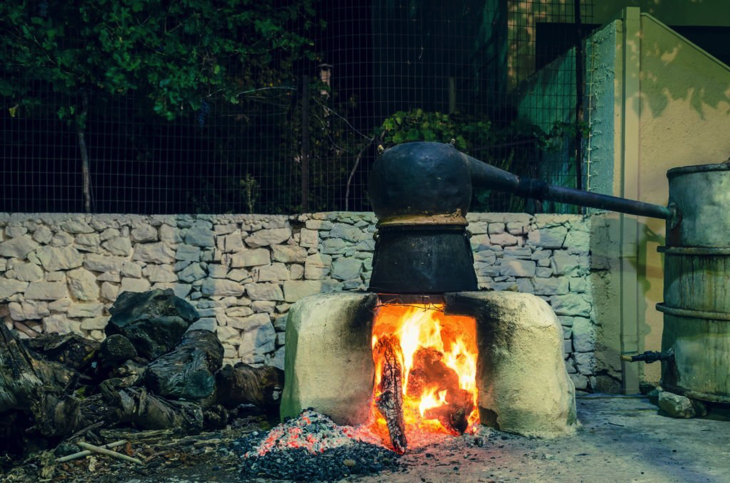
The economic activity of having a cauldron is not that important apart from some extra income. Above all, this practice is a tradition, and something that improves social interaction, so to be in this business is a great honour, nothing else. In the production of tsikoudia, the pot may be left open for one, two, or more days, depending on the number of grapes brought in by the “customer” for distillation. This allows for an all-day feast where the guests make their presence known at any time of the day. So the crowd builds up until intoxication sets in. There are mantinades, dancing and amateur musicians, who set the best standards for the outcome of the evening. The greetings that are heard from the red faces are sometimes original and reflect the temperament and brewing of the Cretans of the hinterland.
Rakokazano is a social phenomenon and a big festival in Crete. The distillation of tsikoudia is at its peak, and the rakokazano have their honour, being a special meeting point of fun and merriment for everyone.
The “mystagogy” of tsikoudia production and the way it runs from the “blessed” pipe, both from the hard work of the farmers and from the songs, the mantinada, and the wishes for good luck, give the impetus for unique Cretan evenings.

Usually, the gatherings in the rakokazano with good company and under the sounds of the Cretan lyra with mantinades and songs that praise the everyday life, the joys, sorrows, and love certainly get the blessing of the positive energy of the participants for its production.
The table at the rakokazano can be simple or extravagant. In any case, local traditional products will certainly make an appearance either as appetisers or as a main course. The charcoal and the hovel of the cauldron fire, of course, provide the solution either as a cooking or heating fire, except for the tsikoudia. Potatoes oftes, which are whole potatoes with the skin roasted in the hot ashes, apaki and sausages on the charcoal, plenty of local goats cooked against the fire, accompany the “protoraki”, which is the fresh batch of raki. And, of course, the seasonal Cretan products: fresh walnuts, chestnuts, pomegranates, apples, and quinces, which give colour to the table.
Does Raki have any Health Benefits?
Cretan raki, when consumed in moderation (1-2 glasses daily), may offer health benefits. It promotes vasodilation, which can lower blood pressure, and has antimicrobial properties. It’s used in traditional remedies for colds, coughs, and headaches. Studies suggest moderate alcohol intake, including raki, may reduce cardiovascular risks and heart attack fatalities.
The maximum beneficial properties of raki are achieved when the person has already adopted a generally healthy lifestyle, which includes a balanced Mediterranean diet, daily exercise, and as much self-restraint from smoking as possible.
What Food Is Raki Best Served With?
The popularity of raki increases with every passing day. It is often famous for its 100% natural without preservatives and additives, an authentic distillate full of flavours and aromas. One thing you should know is that Raki should never be consumed plain. It has to be accompanied by tasty appetisers and other treats. You can enjoy it with Cretan foods like rusks, tomatoes, cucumbers, olives and cheese, seasonal vegetables such as beans and artichokes in the spring, fresh fruit in the summer, or homemade pastries.
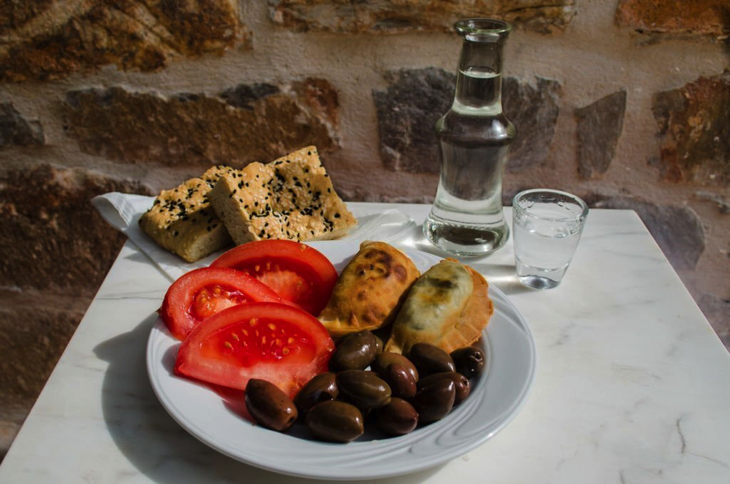
What other drinks should someone try in Crete?
Apart from raki, there are other Cretan drinks that one could enjoy in Crete, which are famous in the famous cretan diet. While on holiday in Crete, you could have an amazing time by drinking the local wines, rakomelo, and ouzo which has an intriguing history dating back 4000 years. Till now, Cretan wines has been an important part of the culture. Vidiano wine is one of the most famous and produces an excellent variety of white wines.
1. Rakomelo
Rakomelo is a popular Greek drink subtly sweet and natural, featuring a hint of spice in the aftertaste. It is usually preferred by those who have not developed a taste for pure raki, and this drink is typically enjoyed in chilly weather and evenings; it can also be served chilled over ice during summer months. Rakomelo is also used as a remedy for coughs and sore throats. It has become popular with both locals and visitors. Rakomelo dates back to the 12th century, with its origins in either the Peloponnese peninsula, Crete, or the Cyclades islands. You can make Rakomelo at home. Just add 1 or 2 teaspoons of honey to every four shots of raki with a teaspoon of cinnamon and clove for taste in a saucepan. It should be gently heated until the honey has melted, and then you can either have it off the pan or refrigerate it before serving.
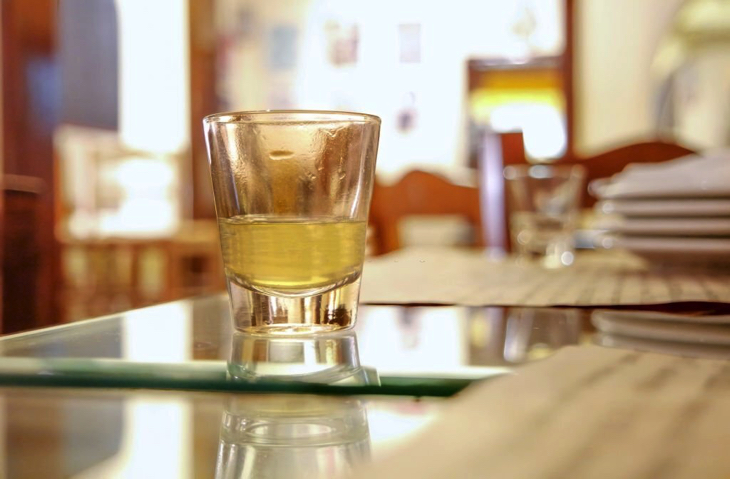
2. Raki vs Ouzo
You might get confused between these two Mediterranean drinks quite easily. When comparing raki with ouzo, there are a few significant differences. First off, Raki has Turkish roots while Ouzo is a beverage that originated in Greece. Yes, the distillation method used in both produces a distinct aniseed flavour by using grape pulp. The alcoholic volumes do, however, vary. The primary difference is that Raki is much, much stronger than Ouzo. You can definitely taste the difference even if you can’t see it.
3. Raki vs Cretan Beers
Apart from this, there are also beers from Crete. It’s not as famous as the others, although organic artisanal beers have been gaining increasing interest in recent years. Some of the brands include Cretan Brewery, Solo Beer, Charma Beer and the brand-new Notos Lager by Notos brewery.
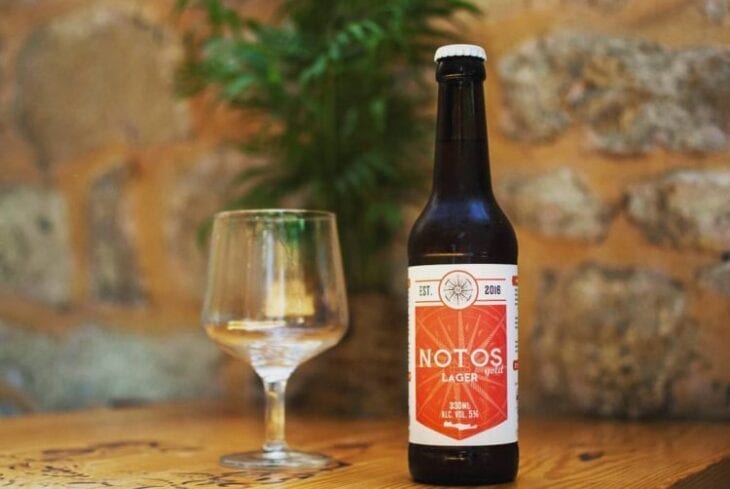
There are also coffee shops at every turn in Greece. You can either buy a traditional Greek coffee brewed in a special pot and served in tiny cups, unfiltered with foam on top and coffee grounds on the bottom or else even have it the regular way. Tea is also something that draws attention. Crete has unique Greek mountain tea, which is also known as shepherd’s tea. It is mild yet has a smooth herbal undertone due to malotira mountain tea found on Crete’s mountain slopes.
4. Cretan Wines
Cretan wine has come a long way since Sir Arthur Evans stumbled upon an ideogram for the word wine in a piece of Linear B, the earliest known form of Greek writing. The island has over 80 producers, with some outstanding efforts in Chania and Sitia. But the greater Heraklion region is where this renaissance is beating. Around 50 farmers call these long-established terroirs home, accounting for 90% of the total production. In Crete, the two indigenous grape varieties most frequently used to make wines are Kotsifali and Liatiko. Additional grapes like Mandilaria and Muscat of Spinas, as well as foreign grapes like Mourvedre and Syrah, are also used. The most extensively planted red grape in Crete is the early-maturing, light-colored Liatika. The Liatiko rosé wines from Kourkoulou, Louloudis, and Lyrarakis are all excellent drinks. The well-known local cuisine and the new generation of Cretan wines make for a delicious pairing, and they will undoubtedly make this part of your journey a culinary treat.

What is the Raki Market now?
The raki (tsikoudia) market has grown significantly, with tsikoudia now a Protected Designation of Origin (PDO) product representing Crete globally. Raki was previously made in small village quantities, but demand surged in the past decade, leading to issues with low-quality, bulk raki. Today, regulated distillation, bottling, and labeling are crucial for maintaining quality and authenticity.

Tsikoudia has now been established as a PDO product, representing traditional Crete all over the world. It is of high importance that tsikoudia receives due attention from the initial phase of distillation, bottling, and distribution to the final consumption.
Where To Buy Raki In Crete?
You can buy Cretan Raki in all souvenir shops around the island and next to the most famous points of interest like Knossos Palace and museums. The best place to buy local Raki in every local markets in Heraklion and Chania. In addition you can buy a pack of a 200ml bottle of raki with 4 shot glasses at the duty free shops in Heraklion or Chania airport.
What are the 3 most popular Raki brands in Crete?
There are three best raki brands to order online or drink from when visiting Crete. The first one is KretaRaki Traditional Cretan Raki. It is made from selected sweet sultanina grapes gathered from mountain vineyards in Crete. The grapes are fermented for 30 days, and then a double extraction follows in order to collect only the pure heart of tsikoudia. Kretaraki Tsikoudia is a pure distillate of superb quality with a peppery and fruity flavour that is characteristic of the authentic Cretan tsikoudia.
DS Distillers company focuses on the creation of high-quality products following all necessary steps in the production chain, with consistency, safeguarding the quality of raw materials, and respecting farmers, nature, and consumers. Their goal is to bring out the best possible outcome and put in place the Cretan Raki and all other Greek distilling products.
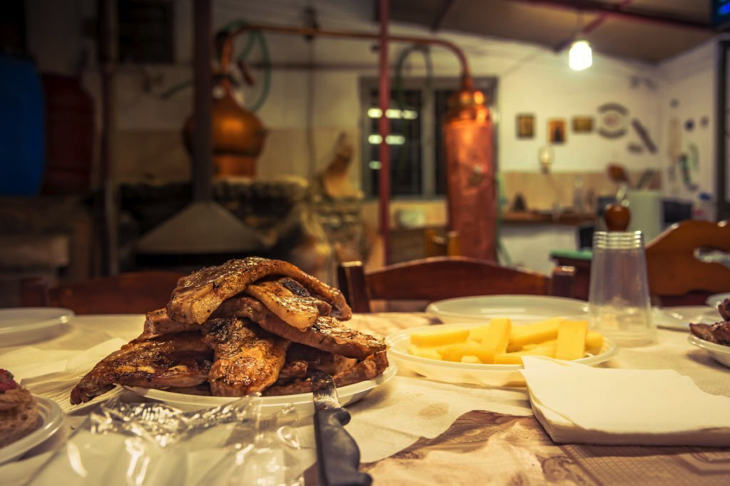
The second one is Tsikoudia Paradise by Domaine Paterianakis. It is the first winery in Crete to produce organic wines. After years of research and many efforts, the Paterianakis sisters, the second generation operating the winery, produced two special single variety tsikoudia spirits using 100% Cretan grape varieties of organic cultivation, tsikoudia from Vidiano and tsikoudia from Kotsifali. The name of this tsikoudia, “Paradise”, is inspired by the land of their vineyards which the Paterianakis family considers to be their own paradise.
Paterianakis winery is open for visitors during summertime. If you ever come to Crete, you should not miss the chance to visit it, taste its organic wines and the unique tsikoudia distillates, walk around the vineyards, and enjoy yourself in this magical landscape.
The last one is Tsikoudia Raki by Vassilakis Estate. It consists of beautiful olive groves and is well-known for the production of excellent olive oil. Among the olive groves, there are some areas where the Vassilaki family cultivates their own vineyards to make their own homemade wine and famous traditional tsikoudia which they bottle in small quantities. You will find Tsikoudia Vassilakis available in 700ml and 200ml bottles.
In the region of Sitia, in eastern Crete, the land is ideal for the cultivation of vineyards. The grape varieties that grow there are used to produce wines and tsikoudia with unique qualitative characteristics. From the organic vineyards of Ktima Toplou is produced a fine tsikoudia distillate that is distinguished for its special aromas and superior quality. However, the diamond of the Ktima Toplou is its aged raki – tsikoudia that is produced from freshly glued marks and is aged in oak barrels.

While there are a lot of brands one could buy raki from, the rich history of these aforementioned ones is what makes them the most famous and delicious. Raki is a way of life in Crete. It not only brightens any social occasion but also helps in bringing people closer together as an ice-breaker. One can even buy raki as a souvenir from Crete, although the flight restrictions for inflight bags make it harder for anyone to take it back home and savour the taste of it outside of Crete. Still, it is considered an act of good fortune and time to come whenever raki is brought forward in a crowd.
What are the alcohol restrictions when driving in Crete?
As in most greek islands, driving in Crete are slightly different than in other areas. Make sure to follow these regulations, and your trip throughout Crete should be a breeze. Just keep in mind that in Crete, traffic travels on the right side of the road and must yield to cars approaching from that direction. Additionally, this implies that vehicles entering a traffic circle are given the right of way while vehicles already in the process must yield. As far as alcohol limitations are concerned, 50mg of alcohol per 100ml of blood is the legal limit in Greece. This amounts to 0.05% of the total. That is equivalent to less than in the USA or the UK, and
- Beer in 490 ml (a large glass)
- 20 ml of wine
- Ouzo 60 ml
- 55 ml of vodka or whiskey
If you are stopped for drunk driving, the fine depends on the alcohol content of your breath (or blood). This might result in fines ranging up to 700 euro, a driving licence suspension of three to six months, the rest of your vehicle’s licence plates for up to six months, and if you are caught a second time within two years, a jail sentence of up to six months. For Crete car rental, the rules are a bit different as the owner of the car is not the driver.
Last updated on October 23rd, 2024














